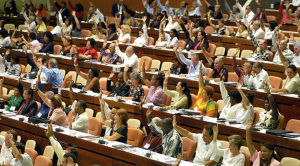
Originally published in Liberation Newspaper, July 2015. The following is an introduction to a longer article on Cuba’s socialist state and how it differs from capitalist states.
I was in Havana on a main street in 1993, during the depths of Cuba’s Special Period. The country was undergoing enormous economic difficulties due to the collapse of the Soviet Union—Cuba’s main trading partner—and the U.S. blockade. I noticed a few police officers at the door of a bus that was stopped. There was loud conversation inside the bus among the passengers because the driver had refused to continue along his route.
The rule of no more than 45 passengers was breeched when too many people had boarded. The driver would not continue driving until some people got off the bus.
At that time, buses were extremely scarce due to lack of spare parts, tires and so on. Great care had to be taken of those buses that did function, including limiting the number of passengers on some buses.
The driver was trying to take care of the bus. And the passengers just wanted to get home after work. No one was about to sacrifice his or her ride home.
The police had come upon the situation and two of them were leaning into the doorway as they talked with the bus driver to resolve the standoff.
The most striking aspect of this incident was three young men, curious about the happenings, standing at the bus door, listening to the police and driver. They were right behind and next to the police, their hands on the police’s shoulders as they leaned on them to get a better view of the incident. If the police had not been in uniform, you would have thought they were friends huddled together.
This small everyday encounter spoke to the relationship in socialist Cuba between the police and the people, of the mutual trust and respect and the lack of fear.
Capitalist versus socialist state
Anybody in the United States knows that such an interaction would be impossible in our “democratic America.”
In the United States, when police confront someone, especially Black or Latino youth, the cops warn bystanders and witnesses to stand far back or face arrest, brandishing their nightsticks or guns to make the point. Sometimes there is no warning.
Whether it is equipping police forces with combat gear to wage war on protesters, or gunning down youth with impunity, or financing town budgets through fines, filling the prisons to record levels, torturous punishment and isolation, or the NSA’s surveillance of every person’s communications, the U.S. capitalist state has reached an unprecedented magnitude of repression.
The U.S. capitalist state apparatus protects a tiny minority of capitalists, bankers, landlords and the government in an inherently antagonistic relationship with the overwhelming majority, the working class and oppressed.
Socialism is the first system where the class that takes power is not a minority exploitative class, but instead represents the vast majority, the producers, the working class and peasantry.
And yet, class antagonisms do not simply end with the overturning of capitalism.
For Cuba—as in all previous and still-existing socialist countries—a state is essential to defend the people and the socialist gains. The armed forces, police, militias, courts and laws exist to protect the people against common crimes, to defend the Revolution against a return to capitalism and against U.S. imperialist aggression.
Read the full version of this article in Revolution Manifesto.






